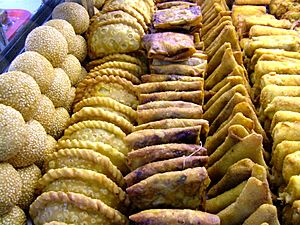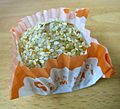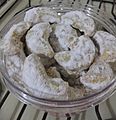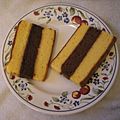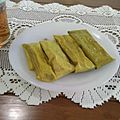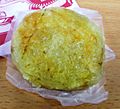Kue facts for kids
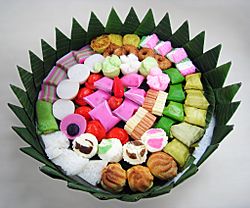
Jajan pasar (market snacks) in Java, consisting of assorted kue
|
|
| Alternative names | Kueh (Hokkian), Kuih (Malaysia, Singapore, Brunei) |
|---|---|
| Course | Snack |
| Place of origin | Indonesia |
| Region or state | Nationwide |
| Main ingredients | Various traditional snacks |
| Similar dishes | Kuih, Mont, Khanom, Bánh |
Kue (pronounced "koo-eh") is a super popular bite-sized snack or dessert from Indonesia. Think of it as a huge family of treats, including everything from cakes and cookies to fritters and pies! The word "kue" itself is a very broad term in the Indonesian language.
Kue come in all shapes, sizes, and flavors. Some are steamed, some are fried, and others are baked. Indonesia has the biggest variety of kue, and because of its history with the Netherlands, these tasty snacks are also loved there!
Indonesian kue show off a mix of different cultures. You can find local Indonesian treats, influences from Chinese and Indian cooking, and even European cakes and pastries. For example, some kue like bakpia and kue ku come from Chinese traditions. Kue putu is similar to an Indian dish called puttu. Many others, like kue bugis and klepon, are truly Indonesian. Then there are kue like lapis legit and kastengel that were inspired by European baking. In Java, many traditional kue are called jajan pasar, which means "market buys." These colorful jajan pasar are often given as gifts or served at special Javanese ceremonies.
Contents
What is Kue?
The word "kue" comes from the Hokkien language, which is a Chinese dialect. It's also spelled kuih in Malaysia and kueh in Singapore. Many kue are steamed instead of baked, which gives them a different texture and taste compared to Western cakes. While many are sweet, some kue are savory too!
Indonesian kue are usually put into two main groups based on how moist they are:
- Kue basah (wet kue): These are moist and soft.
- Kue kering (dry kue): These are more like cookies and can last longer.
The word "kue" in Indonesia isn't just for traditional snacks. It also includes all kinds of cakes and some pastries. So, many Western cakes could be called kue basah, and many kue kering are actually pastries!
What are Kue Made From?
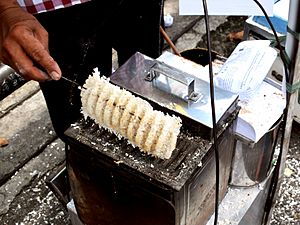
Many traditional Indonesian kue, whether sweet or savory, are made with rice flour and coconut. For sweetness, they often use gula aren (palm sugar), but regular sugar is also common. Rice flour and tapioca are very popular flours. However, because of foreign influences, wheat flour is also used a lot now.
To make kue creamy and tasty, traditional recipes use coconut milk. But nowadays, you'll also find dairy products like milk, cream, butter, cheese, and margarine. Popular flavors and spices include coconut, peanut, green pandan (a fragrant leaf), ginger, cinnamon, vanilla, and chocolate.
Where to Find Kue
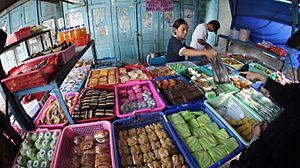
Today, in Indonesian cities, kue are popular snacks for brunch or an afternoon treat, often enjoyed with coffee or tea. You can find different kinds of kue alongside Western pastries and cakes in cafes, coffee shops, and snack stalls.
Traditionally, kue are made for special celebrations like lebaran (Eid al-Fitr) or Natal (Christmas). Families and communities often make them at home. For example, the royal palace in Yogyakarta has a special Ngapem ceremony where they cook kue apem together. Selling kue is also a great business, and you can commonly find them in morning markets called pasar pagi as jajan pasar.
Kue are also one of the most popular street foods in Indonesia. Street vendors with carts often visit neighborhoods or set up near markets and schools. Some kue, like kue rangi and kue putu, are usually found in residential areas, while others like kue ape and kue cubit are often sold near markets or schools.
In the Netherlands, you can find a variety of koeé in Indo toko (shops) and eetcafe snack shops.
Wet Kue (Kue Basah)
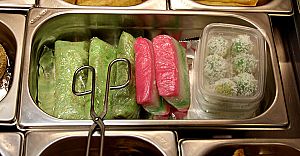
Most traditional Indonesian kue are kue basah (wet kue). They are usually soft and moist, and they are often steamed or fried instead of baked. Kue basah is typically made with rich coconut milk, sugar, and rice flour. Because of this, they don't last very long, usually only a day or two, especially in Indonesia's hot and humid climate. Here are some examples:
- Kue agar-agar: A jelly-like pudding.
- Kue ape: A thin pancake with a thicker center, sometimes called kue tetek.
- Kue apem: Similar to a Malay pancake, made from cassava tapai, coconut water, rice flour, and coconut milk. It's steamed until fluffy and served with grated coconut.
- Kue arem-arem: A rice cake wrapped in a banana leaf, filled with diced vegetables, tempeh, or minced meat.
- Kue bahulu: Small, crusty sponge cakes baked in special molds, often shaped like buttons or goldfish. They are popular for celebrations.
- Kue bakpia: A Chinese pastry filled with beans, very popular in Yogyakarta.
- Kue bika ambon: A yellow, spongy cake made from tapioca and sago flour, eggs, sugar, and coconut milk. It often has a pandan flavor.
- Kue bolen: A baked pastry with layers like a croissant, filled with cheese and banana. It shows European pastry influences.
- Kue bolu kukus: A steamed bun made of flour, sugar, eggs, and flavoring like vanilla or chocolate.
- Kue bugis: A steamed glutinous rice flour cake, often green with pandan, filled with grated coconut and coconut sugar, and wrapped in a banana leaf.
- Kue cubit: A small, round cake made from flour, baking powder, sugar, and milk. It's often topped with chocolate sprinkles. Its name means "pinch" because it's so small!
- Kue cucur: A pancake made of fried rice flour batter and coconut sugar.
- Kue dadar gulung: Grated coconut with coconut sugar wrapped inside a thin green crepe made of rice flour.
- Kue dodol: A sticky, chewy sweet made from rice flour, sweetened with coconut sugar, and often flavored with fruits like durian.
- Kue getuk: Made from cassava flour and coconut sugar, served with sweetened grated coconut.
- Kue klepon: Green balls of glutinous rice flour filled with liquid palm sugar. They are boiled or steamed and then rolled in grated coconut.
- Kue lapis: A colorful layered cake made of glutinous rice flour, coconut, and sugar.
- Kue lapis legit: Also known as spekkoek, this is a rich cake with many thin layers made of butter, eggs, and sugar. Each layer is cooked separately, making it a very special cake!
- Kue lemper: Made of glutinous rice filled with chicken, fish, or meat floss. It's rolled up like an egg roll.
- Kue lumpia: A spring roll with savory or sweet fillings, often fried.
- Kue lupis: Compressed glutinous rice served with grated coconut and coconut sugar syrup.
- Kue martabak: A stuffed pancake or pan-fried bread, often filled with vegetables and minced meat.
- Kue nagasari: A traditional steamed cake made from rice flour, coconut milk, and sugar, filled with slices of banana.
- Kue onde-onde: Similar to Chinese sesame balls, filled with sweet mung bean paste and coated in sesame seeds.
- Kue pastel: A pastry filled with meat (usually chicken) and vegetables, then deep-fried. It's similar to a curry puff but without the curry.
- Kue putu: Rice flour with green pandan leaf coloring, cooked with palm sugar filling, steamed in bamboo pipes, and served with grated coconut.
- Kue rangi: A coconut waffle made from sago flour and shredded coconut, served with palm sugar sauce.
- Kue risoles: Minced meat, beans, and carrots wrapped in a thin omelette, coated with bread crumbs, and fried.
- Kue serabi: A pancake made from rice flour with coconut milk or shredded coconut.
- Kue wajik: A diamond-shaped sweet cake made from sticky glutinous rice.
- Kue wingko: A traditional Javanese pancake-like snack made from coconut.
Dry Kue (Kue Kering)
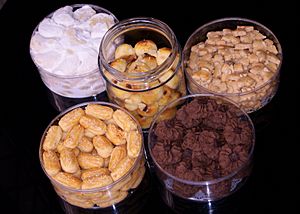
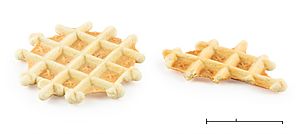
In Indonesian, kue kering (dry kue) are very similar to Western cookies. Most kue kering are baked or fried and have very little water, so they last much longer than kue basah. Some, like kaasstengels, clearly show their Dutch origins (kaas means cheese in Dutch). Kue kering are often served during holidays like Lebaran and Natal to guests. Here are some examples:
- Kue akar kelapa
- Kue bangkit: A sago cookie.
- Kue bola keju
- Kue cistik: Cheese sticks.
- Kue gapit: A tapioca waffle.
- Kue jahe: Ginger cookies.
- Kaasstengels: Cheese cookies.
- Kue kuping gajah: Elephant ear cookies.
- Kue leker: A stuffed, crispy crepe.
- Kue lidah kucing: Cat's tongue cookies.
- Kue nastar: A small, round pastry with pineapple jam filling.
- Kue putri salju: Cookies coated with white powdered sugar, like "snow princess" cookies.
- Kue semprong: A cone-shaped pastry.
- Kue sagu: Sago cookies.
- Kue satu: A sweet, crumbly cookie.
- Kue semprit: A flower-shaped cookie.
Images for kids
-
Kue apem at Lok Baintan Floating Market
-
Kue clorot or cerorot
-
Kue dadar gulung
-
Kue nagasari
-
Kue klepon
-
Lapis legit and kue lapis
-
Kue semprong
-
Kue timphan
-
Kue ku, derived from Chinese Ang Ku Kueh
-
Kue wingko babad


